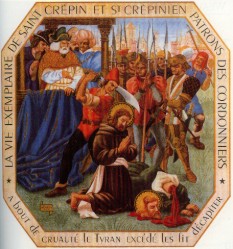S. Crispin, without his brother S. Crispinian, was one of those saints restored to the Prayer Book calendar in 1559 and maintained in the 1662 Book. The day must have been dear to the English because it was on this day in 1415 that Henry V triumphed over the French at the Battle of Agincourt. Shakespeare had a good Catholic memory, when he composed the famous speech of Henry V on the eve of the battle (Henry V, Act iv, Scene3):
This
day is called the feast of Crispian:
He
that outlives this day, and comes safe home,
Will
stand a tip-toe when the day is named,
And
rouse him at the name of Crispian.
He
that shall live this day, and see old age,
Will
yearly on the vigil feast his neighbours,
And
say 'To-morrow is Saint Crispian:'
Then
will he strip his sleeve and show his scars.
And
say 'These wounds I had on Crispin's day.'
Old
men forget: yet all shall be forgot,
But
he'll remember with advantages
What
feats he did that day: then shall our names.
Familiar
in his mouth as household words
Harry
the king, Bedford and Exeter,
Warwick
and Talbot, Salisbury and Gloucester,
Be
in their flowing cups freshly remember'd.
This
story shall the good man teach his son;
And
Crispin Crispian shall ne'er go by,
From
this day to the ending of the world,
But
we in it shall be remember'd;
We
few, we happy few, we band of brothers;
For
he to-day that sheds his blood with me
Shall
be my brother; be he ne'er so vile,
This
day shall gentle his condition:
And
gentlemen in England now a-bed
Shall
think themselves accursed they were not here,
And
hold their manhoods cheap whiles any speaks
That
fought with us upon Saint Crispin's day.
Their legend from the Catholic Encyclopedia: (http://www.newadvent.org/cathen/04491a.htm)
Martyrs
of the Early Church who were beheaded during the reign of Diocletian; the date
of their execution is given as 25 October, 285 or 286. It is stated that they
were brothers, but the fact has not been positively proved. The legend relates
that they were Romans of distinguished descent who went as missionaries of the
Christian Faith to Gaul and chose Soissons as their field of labour. In
imitation of St. Paul they worked with their hands, making shoes, and earned
enough by their trade to support themselves and also to aid the poor. During
the Diocletian persecution they were brought before Maximianus Herculius whom
Diocletian had appointed co-emperor. At first Maximianus sought to turn them
from their faith by alternate promises and threats. But they replied: "Thy
threats do not terrify us, for Christ is our life, and death is our gain. Thy
rank and possessions are nought to us, for we have long before this sacrificed
the like for the sake of Christ and rejoice in what we have done. If thou
shouldst acknowledge and love Christ thou wouldst give not only all the
treasures of this life, but even the glory of thy crown itself in order through
the exercise of compassion to win eternal life." When Maximianus saw that
his efforts were of no avail, he gave Crispin and Crispinian into the hands of
the governor Rictiovarus (Rictius Varus), a most cruel persecutor of the
Christians. Under the order of Rictiovarus they were stretched on the rack,
thongs were cut from their flesh, and awls were driven under their
finger-nails. A millstone was then fastened about the neck of each, and they
were thrown into the Aisne, but they were able to swim to the opposite bank of
the river. In the same manner they suffered no harm from a great fire in which
Rictiovarus, in despair, sought death himself. Afterwards the two saints were
beheaded at the command of Maximianus.
"This story shall the good man teach his son."


No comments:
Post a Comment
Comments